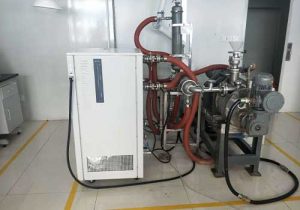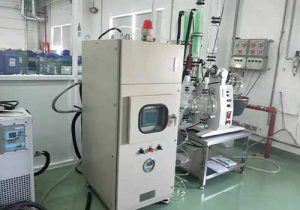chiller cool
How Chillers Achieve Efficient Cooling
Introduction
The term “chiller cool” refers to the ability of chiller systems to reduce and maintain the temperature of a fluid, typically water or air, to a desired level. Chillers are integral to numerous industrial, commercial, and even some residential applications, providing essential cooling for processes, equipment, and indoor environments. Understanding how chillers achieve this cooling effect is crucial for optimizing their performance, selecting the right chiller for specific needs, and ensuring energy – efficient operation.

The Fundamental Principle: Vapor Compression Refrigeration Cycle
The cornerstone of chiller cooling is the vapor compression refrigeration cycle, which comprises four main processes: compression, condensation, expansion, and evaporation.
Compression
At the heart of the chiller is the compressor, which initiates the cycle. The compressor draws in low – pressure, low – temperature refrigerant vapor from the evaporator. As the refrigerant enters the compressor, mechanical components within, such as pistons in reciprocating compressors or meshing rotors in screw compressors, exert force on the vapor. This compression increases the pressure and temperature of the refrigerant significantly, transforming it into a high – pressure, high – temperature vapor. The now – compressed refrigerant vapor is then discharged from the compressor, ready to move on to the next stage of the cycle.
Condensation
The high – pressure, high – temperature refrigerant vapor travels to the condenser. In the condenser, the refrigerant releases its heat to a cooling medium. For air – cooled chillers, ambient air serves as the cooling medium. Finned – tube heat exchangers in the condenser maximize the surface area, and fans blow air over the tubes, facilitating the transfer of heat from the refrigerant to the air. As heat is dissipated, the refrigerant condenses from a vapor state back into a liquid state. In water – cooled chillers, water is the cooling medium. The refrigerant passes through the shell side of a shell – and – tube condenser or between plates in a plate – type condenser, while water flows through the tubes or between the plates, absorbing the heat from the refrigerant and causing it to condense. The warm water is then either cooled in a cooling tower or recycled through other cooling mechanisms.
Expansion
The high – pressure liquid refrigerant leaving the condenser proceeds to an expansion device, commonly a thermostatic expansion valve (TXV) or an electronic expansion valve (EXV). The expansion valve reduces the pressure of the refrigerant abruptly. As the pressure drops, the refrigerant expands and experiences a significant decrease in temperature, becoming a low – pressure, low – temperature liquid – vapor mixture. This drop in temperature makes the refrigerant ready to absorb heat in the next stage of the cycle. Additionally, the expansion valve regulates the flow of refrigerant into the evaporator, ensuring an appropriate amount of refrigerant enters to maintain efficient heat absorption.

Evaporation
In the evaporator, the low – pressure, low – temperature refrigerant mixture comes into contact with the fluid that needs to be cooled, such as water or air. As the refrigerant absorbs heat from the fluid, it evaporates back into a vapor state. This heat – absorption process cools the fluid, which can then be circulated to cool various processes or spaces. For example, in an air – conditioning system, the cooled water from the chiller’s evaporator can be used to cool the air in a building. Once the refrigerant has fully evaporated, it is drawn back into the compressor, restarting the cycle and continuing the cooling process.
Types of Chillers and Their Cooling Approaches
Air – Cooled Chillers
Air – cooled chillers rely on ambient air to cool the refrigerant in the condenser. They are relatively simple in design and installation, as they do not require a complex water – cooling infrastructure like cooling towers or extensive plumbing. These chillers are commonly used in applications where access to a reliable water supply is limited or costly, such as small commercial buildings, light – industrial facilities, and some outdoor installations. The cooling process in air – cooled chillers involves fans blowing air over the finned – tube condensers, which transfer the heat from the refrigerant to the surrounding air. While they offer convenience, air – cooled chillers generally have a lower cooling efficiency compared to water – cooled chillers due to the lower heat – transfer capacity of air compared to water.
Water – Cooled Chillers
Water – cooled chillers utilize water as the cooling medium in the condenser, enabling them to achieve higher cooling efficiencies. They are suitable for applications with high cooling demands and where a stable water supply is available, such as large commercial buildings, data centers, and industrial plants. In a water – cooled chiller, the refrigerant releases heat to the water in the condenser, and the warm water is then cooled in a cooling tower or other water – cooling devices before being recycled back to the chiller. The use of water as a cooling medium allows for lower condensing temperatures, which in turn improves the overall efficiency of the chiller. However, water – cooled chillers require additional components for water treatment to prevent scale and corrosion, and the maintenance of the water – cooling system can be more complex.
Absorption Chillers
Absorption chillers operate on a different principle compared to vapor – compression chillers. Instead of using mechanical compression, they rely on a heat – driven process. These chillers use a refrigerant (commonly water) and an absorbent (such as lithium bromide). Heat from a source like steam, hot water, or combustion gases is used to drive the absorption process. The refrigerant vapor is absorbed by the absorbent, and then the mixture is heated to release the refrigerant vapor, which then goes through the condensation, expansion, and evaporation processes similar to vapor – compression chillers. Absorption chillers are often used in applications where there is a readily available waste – heat source, as they can effectively utilize this otherwise wasted energy for cooling, providing an energy – efficient and environmentally friendly cooling solution.
Factors Influencing Chiller Cooling Performance
Refrigerant Selection
The choice of refrigerant has a significant impact on chiller cooling performance. Different refrigerants have varying thermodynamic properties, such as boiling points, heat – transfer coefficients, and critical temperatures. Modern refrigerants are also selected with environmental considerations in mind, as many older refrigerants have been phased out due to their ozone – depleting or high global – warming potential. For example, R134a and R410A are commonly used in contemporary chillers as they are more environmentally friendly while still providing efficient cooling. The refrigerant’s properties determine how effectively it can absorb and release heat during the refrigeration cycle, influencing the overall cooling capacity and efficiency of the chiller.
Heat Exchanger Design
The design of the heat exchangers (condensers and evaporators) in a chiller is crucial for efficient heat transfer. A well – designed heat exchanger maximizes the surface area available for heat exchange while minimizing pressure drops. In finned – tube heat exchangers, the fins increase the surface area, allowing for more heat to be transferred between the refrigerant and the cooling medium (air or water). Plate – type heat exchangers use a series of corrugated plates to create a large heat – transfer surface area in a compact space, enabling efficient heat exchange. The material of the heat – exchanger tubes or plates also affects performance, with materials like copper and stainless steel commonly used for their good heat – transfer and corrosion – resistance properties.
System Maintenance
Regular maintenance is essential for maintaining optimal chiller cooling performance. Over time, components such as the compressor, heat exchangers, and expansion valves can accumulate dirt, debris, or experience wear and tear. Cleaning the heat exchangers regularly helps remove fouling, which can impede heat transfer and reduce cooling efficiency. Checking and maintaining the refrigerant levels and ensuring proper lubrication of the compressor are also crucial. Additionally, calibrating the control system, including temperature and pressure sensors, ensures accurate operation and efficient cooling. Neglecting maintenance can lead to decreased cooling capacity, increased energy consumption, and potential system failures.
Applications of Chiller – Cooled Systems

Industrial Applications
In the industrial sector, chillers are used extensively for cooling various processes. In manufacturing plants, they cool machinery, such as injection – molding machines, to maintain precise operating temperatures and ensure product quality. In the chemical industry, chillers cool reactors and distillation columns to control chemical reactions and prevent overheating. In food processing, chillers are used to cool and preserve food products during processing, storage, and transportation. They also cool the water used in beverage bottling lines to ensure the proper temperature for filling and capping.
Commercial Applications
Commercial buildings rely on chillers for air – conditioning. Large shopping malls, hotels, hospitals, and office buildings use central chiller systems to cool the indoor air, providing a comfortable environment for occupants. Data centers, which generate a significant amount of heat from servers and other electronic equipment, also depend on chillers to maintain the optimal temperature and humidity levels for equipment operation. A well – functioning chiller system in a data center is crucial for preventing server failures and ensuring continuous data availability.
Residential Applications (in some cases)
In some high – end residential buildings or large homes, chillers may be used for central air – conditioning systems. These systems provide more precise temperature control and greater cooling capacity compared to traditional split – system air conditioners. Chillers can also be used in combination with radiant floor cooling systems to provide a more energy – efficient and comfortable cooling solution for residential spaces.
Conclusion
“Chiller cool” is achieved through a complex yet well – engineered process based on the vapor compression refrigeration cycle or alternative heat – driven processes in absorption chillers. Different types of chillers, with their unique cooling approaches, cater to a wide range of applications. Understanding the factors that influence chiller cooling performance, from refrigerant selection to system maintenance, is key to ensuring efficient and reliable cooling. Whether in industrial, commercial, or residential settings, chillers play a vital role in maintaining the desired temperature levels, enabling various processes and ensuring comfort. By having a comprehensive knowledge of how chillers work and how to optimize their operation, users can make informed decisions regarding chiller selection, installation, and maintenance, maximizing the benefits of these essential cooling systems.
Related recommendations
hot water chiller system
817A hot water chiller system is a versatile component of the Heating, Ventilation, and Air Conditioning (HVAC) industry, designed to maintain optimal temperatures in various environments. These syst...
View detailsLow Temperature Chiller Equipment for Hydrogen Production Machine
1767Low Temperature Chiller Equipment for Hydrogen Production Machine In the hydrogen production process of water electrolysis, once the temperature rises uncontrollably, the hydrogen production...
View detailschiller supplier
625Understanding Chiller Suppliers and Their Role in the HVAC Industry What is a Chiller Supplier? A chiller supplier is a company that specializes in the design, manufacture, and distribution ...
View detailsRefrigeration Chiller for Distillation and Extraction
1680Refrigeration Chiller for Distillation and Extraction Carbon dioxide is an industrial gas, and its preparation process is quite complicated. Among them, low-temperature pre-cooling, rectific...
View details
 LNEYA Chiller
LNEYA Chiller







HelloPlease log in